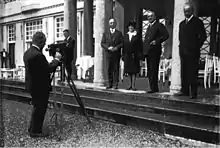Karl Henry von Wiegand
Karl Henry von Wiegand (born 11 September 1874[1] in Hesse in Germany; died 1961) was a German born American journalist and war correspondent. The New York newspaper The Sun printed that Karl H Von Wikgand was the only American correspondent allowed to stay in Berlin during First World War.[2]
Karl Henry von Wiegand | |
|---|---|
 Journalists being photographed before a launch of the Graf Zeppelin, left to right: Karl von Wiegand, Lady Drummond-Hay, Rolf Brand, and Robert Hartmann | |
| Born | 11 September 1874 Hesse, Germany |
| Died | 7 June 1961 (aged 86) Switzerland |
| Occupation | Journalist |
| Spouse(s) | Inez von Wiegand |
Career
Von Wiegand worked from 1911 until 1917 for the United Press and from 1917 for Hearst Newspapers.
World War I
From the outbreak of the First World War Wiegand worked to influence American public opinion in favour of Germany and against the Allies. In 1915 he published Current misconceptions about the war, containing an interview with the German crown prince, and several essays, and a series of letters, all presenting the German point of view.[3] Wiegand was the first United States reporter allowed to interview Crown prince Wilhelm.[4] That interview was also the first foreign interview given by a German noble since the outbreak of World War I.[4] William E. Dodd, US ambassador to Germany during the Roosevelt administration later described him as a "very strongly pro-German representative through the Great War"[5]
Karl von Wiegand was the father of journalist (also for Hearst's Newspapers) and abstract painter Charmion von Wiegand.[6]
Interwar career
He was one of the Hearst Press reporters on at least two of the Graf Zeppelin flights, usually accompanying fellow Hearst reporter Lady Hay Drummond-Hay.[7][8] Wiegand was one of the first American journalists to interview Hitler, having first met him in 1921 while he was only a minor malcontent in post-World War I Munich. He was one of the first journalists to take Hitler seriously, and his story was published on November 12, 1922, a year before the Beer Hall Putsch.[9] As such, Wiegand provided the first introduction Americans had to Hitler. He referred to him as the "German Mussolini", and expressed genuine concern about his popularity, writing "The shadow of the Fascisti is arising in Germany. Whether what is yet only a shadow will clothe itself in the flesh, blood and spirit of the German Mussolini, depends on a number of things." He also emphasized his "man of the people" qualities, his charisma, and his electrifying speaking ability. He pegged him as a potentially great leader, saying "Hitler has the earmarks of a leader. Whether it be merely a band or a great movement, only the future will tell."[10][11]
World War II and after
A month after Germany invaded France in World War II, Wiegand secured an interview with Hitler and published his report "Europe for the Europeans: Adolf Hitler on the international situation during the war in France; An interview granted to Karl v. Wiegand, Führer's Headquarters, June 11, 1940".[12]
Later, Lady Drummond-Hay and Wiegand were interned in a Japanese camp in Manila, Philippines.[13] When they were set free in 1943,[14] she was very ill. They returned to the United States, but during their stay in New York Drummond-Hay died of coronary thrombosis in the Lexington Hotel.[13] After her cremation, Karl brought her ashes back to the United Kingdom.
He died of pneumonia in Zurich in 1961 at the age of 86.[15]
Bibliography
Notes
- Institute for Research in Biography 1948, p. 4875.
- The Sun, August 16, 1914, p. 1.
- Wiegand 1915.
- Elter page 74
- "Dodd-->FDR" 3/20/35
- "Charmion von Wiegand (1896–1983) chronology". Michael Rosenfeld Gallery, LLC. Archived from the original on 26 November 2010. Retrieved 14 December 2010.
- Time magazine: Los Angeles to Lakehurst, 9 September 1929
- Daniel Grossman, Lady Grace Hay-Drummond-Hay / Airships: A Zeppelin History Site, retrieved 5 April 2009
- Rhodes 2007, p. 33.
- Nagorski, Andrew (2012). Hitlerland: American Eyewitnesses to the Nazi Rise to Power. Simon & Schuster. ISBN 978-1-4391-9100-2. p. 22.
- "What newspapers said about Hitler in 1922 (before the Beer Hall Putsch)". www.pagef30.com.
- Katalog der Deutschen Nationalbibliothek
- Time, Time magazine, 25 February 1946
- "Register of the Karl H. Von Wiegand papers". content.cdlib.org.
- Time magazine (16 June 1961), Larger Than Life, retrieved 5 April 2009. Obituary.
References
- Andreas Elter (April 2003), Die andere Front: Pressepolitik in den USKriegen des 20. Jahrhunderts (PDF) (in German), Cologne, archived from the original (PDF) on 18 July 2011, retrieved 5 April 2009 Doctorate dissertation
- Institute for Research in Biography (1948). World Biography, Volume 2. Institute for Research in Biography. Retrieved August 16, 2020.
- Rhodes, Richard (2007). Masters of Death: The SS-Einsatzgruppen and the Invention of the Holocaust. Knopf Doubleday Publishing Group. ISBN 9780307426802. - Total pages: 368
- "Germany Recks Not Cost of Lives Of Men". The Sun. NYC, New York: Benj. H. Day. August 16, 1914. pp. 1–80. ISSN 1940-7831. OCLC 9406339. Retrieved August 16, 2020.
- Wiegand, Karl Henry von (1915). Current misconceptions about the war. 1123 Broadway, New York City: The Fatherland corporation, inc. Retrieved August 16, 2020.CS1 maint: location (link) - Total pages: 40
External links
- Register of the Karl H. Von Wiegand Papers, 1911–1961. The Online Archive of California. (Collection open for research)
- CeiberWeiber *War *Bella Fromm (in German), archived from the original on 20 November 2004,
Er betrachtet Hitler als den Mann, der es ernst meint, und zwar schon seit 1921
- Dodd-->FDR 3/20/35, 20 March 1935,
very strongly pro-German representative through the Great War ... conversation I had on March 15 with Karl von Wiegand
Text version of letter US-ambassador William E. Dodd sent to U.S. President Franklin D. Roosevelt on Wiegand's relationship with Germany - Karl Henry von Wiegand in the German National Library catalogue